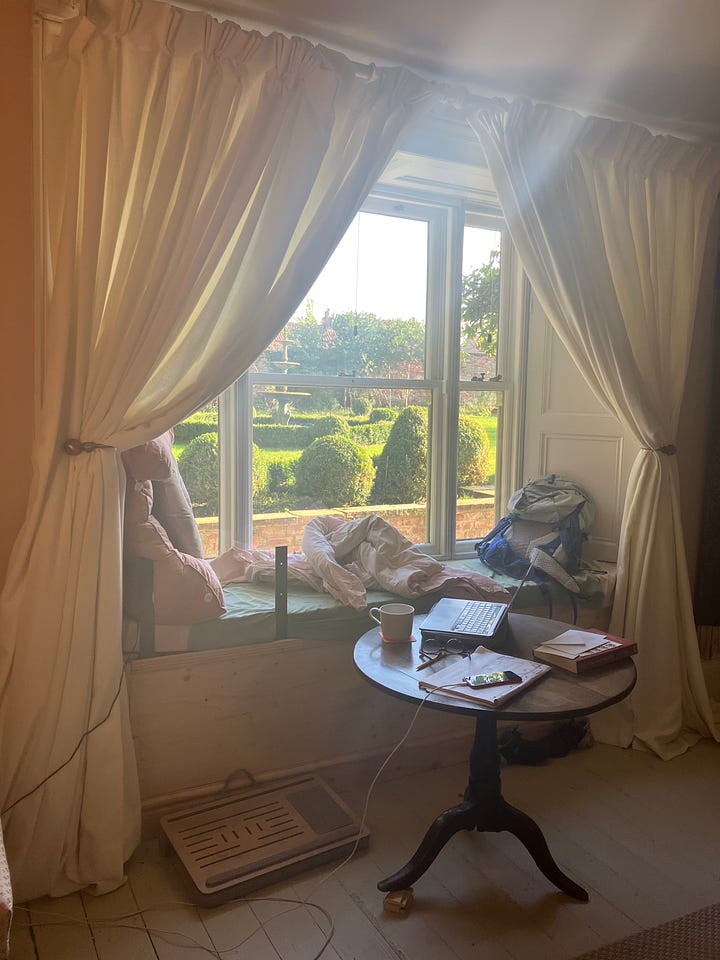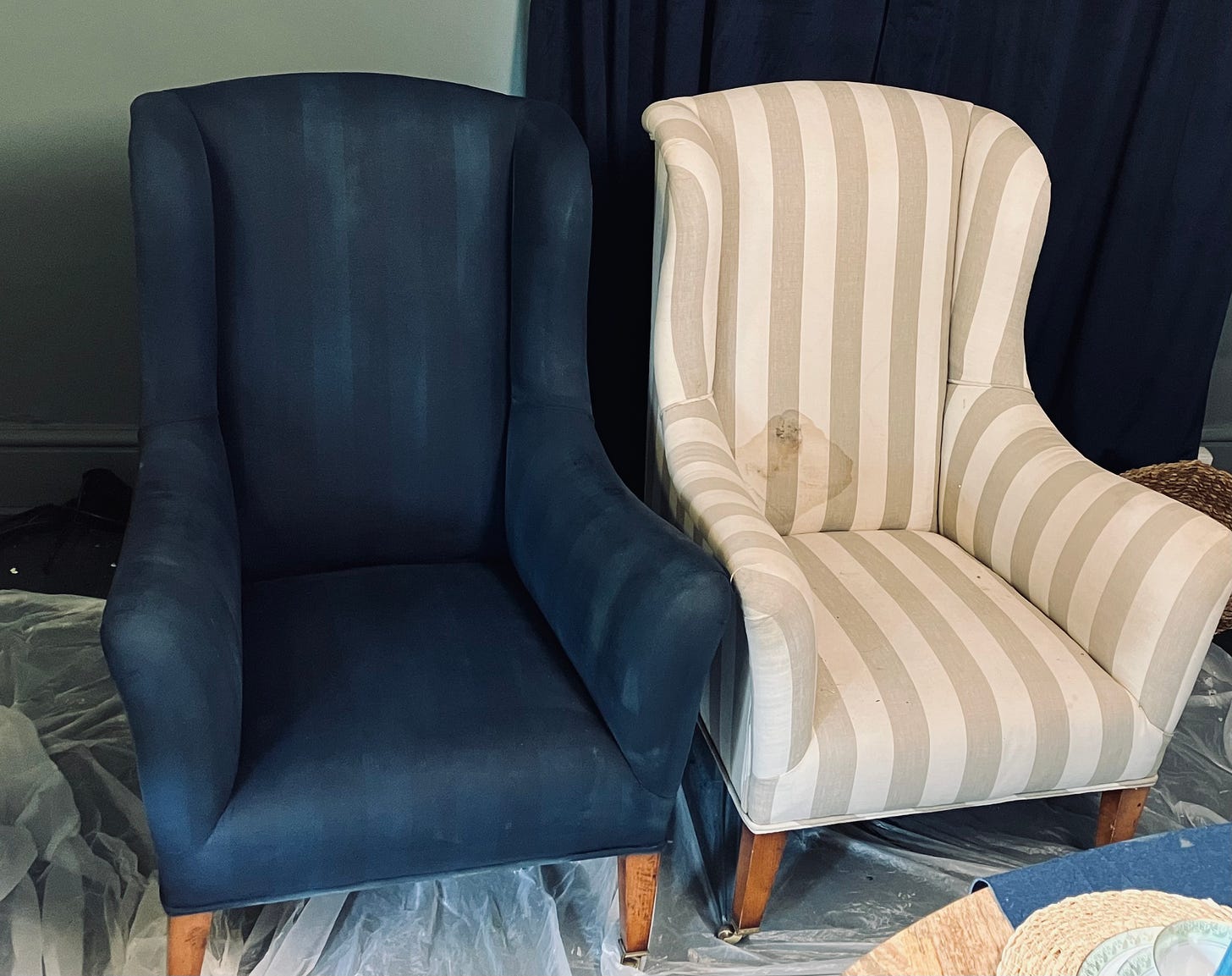It’s been a while since I’ve done an interiors/DIY post, so I thought I’d do a summary of all the little projects in which I’ve been engaged over the last month or so. In late August, I posted about my hatred of the autumn and winter months: the ubiquitous decay that makes me think of death, the darkness that restricts my outdoor hours, the painful cold.
Usually I go into denial, and try and pretend that autumn and winter aren’t happening and then, when it becomes impossible to deny it, I start counting down the days until spring. But this autumn, I thought I’d do things differently, and instead lean into the cold, dark months, and properly prepare for them. I hope that it will feel that autumn and winter are happening with my consent, rather than against my will, if that makes any (narcissistic) sense! So I’ve thrown myself into preparing the garden for winter - cutting back all the summer growth and setting things up for a new start in the spring, plus making it as beautiful as possible with winter lighting - as well as creating nooks around the house in which to curl up with a blanket and keep warm. Maybe some of these ideas will strike a chord for you too?
Painting fabric armchairs
About a year ago, I bought a pair of small fabric armchairs on eBay. I wanted them for the corners of the dining room (which has a wood-burning stove), so they needed to be small enough to fit in a space that also houses a large round dining table. But small armchairs tend to have low backs, and I wanted chairs in which I could rest my head, so when I found a pair of armchairs with the right shape and dimensions, I bought them - even though the fabric was stained and needed re-covering. I’ve been planning to re-cover them for about a year, but it’s quite a big job and I found it hard to settle on a fabric. So instead, I thought I’d try painting them.
I’ve painted a fabric armchair before, using this method of watering down chalk paint so that it forms a dye wash, and painting it onto damp/wet fabric, in lots of coats, until the original colour is concealed. I think I then dabbed on a bit of furniture wax, to soften the fabric. It does work, but it takes a LOT of coats (I think I did 6 or 7 coats), and it changes the texture of the fabric, so that it ends up feeling like faux-leather. The paint also cracks over time, so it’s best used for decorative pieces of furniture, rather than ones that are sat on, day in day out.
When I was trying to find the instructions for painting fabric in chalk paint, I came across a relatively new product, called Fabricoat. It’s a paint that’s specifically designed for upholstery fabric: chairs, lampshades and so on. So I thought I’d give it a go, in Dark Blue. The process is similar to painting in chalk paint, although you don’t need to water down Fabricoat paint. I dampened the fabric armchairs using a sponge and a spray bottle, then painted them, and left them to dry (with a dehumidifier next to them, to speed it up), and repeated the process. The original fabric was cotton, with cream and linen-brown stripes. It took many more coats to achieve an even, saturated coverage than the website had suggested - I think I ended up doing 4 coats on each chair, vs the recommended 1-2 coats. But I’m really pleased with the results: the fabric feels much more natural than when painting with chalk paint. It’s a bit stiff, but that should relax when I’ve sat on them a bit. I used 2.5 litres of paint for 2 small armchairs, which cost £59.95 in total.
Indoor log storage
I’m trying to reduce our gas bill by (a) wearing warmer clothes, (b) insulating the windows with perspex secondary glazing, and (c) heating individual rooms in the house via real fires, rather than using the central heating. I store our logs in an outbuilding, but I want to keep a week’s worth in the house itself, so that I don’t have to keep going back and forth with a wheelbarrow. There’s a small alcove beside our fireplace which is perfect for logs - but the indoor log storage I found online was either pathetically small (only big enough for one fire’s-worth of logs), the wrong dimensions, or ridiculously expensive. I had a couple of black clothes hanging rails left over from when I’d redecorated one of my daughter’s bedrooms, so it occurred to me that I could use those to secure a pile of logs in the alcove. I criss-crossed a couple of black bungee cords across the hanging rails, so that the logs don’t slip out. Total cost: hanging rails were £16.99 each; bungee cords were £8.99 for 4.
Window seats with storage
I’ve become a bit obsessed with creating nice spots around the house in which to curl up with a duvet on cold days. (In fact, I’m writing this from one of these spots, duvet on lap, cat by feet.) I also needed a bit of extra storage, so I built myself two window benches with some left-over wood in my shed. I pretty much followed the instructions in this blog post, but I left mine free-standing, instead of screwing them into the wall, because the panelling around my windows is very very old, and I was reluctant to damage it. I also want to be able to pull the benches away from the wall now and again, to make sure that no damp or mould is developing behind them. For the window seat in my study, I built a frame, then clad it and attached trim. For the bench in the sitting room, I built the frame, and then used it to support shelves for books. I then bought some upholstery foam from an online made-to-measure place, and, when I get around to it, I’ll cover the foam seats in some fabric (it’s dead easy - you just need a bit of MDF that roughly the same size or a bit smaller than the foam, to act as its base, and then you pull the fabric evenly around the foam and use a staple gun to staple the edges to the MDF). I’ll finish both off in a few months: I still need to paint them both, properly upholster them, and the one in the living room needs some trim attaching to it - but first, I need to build a proper built-in library in that room.
Because of the dimensions of the bay windows, the window benches are quite narrow, and I was a bit worried about sliding sideways off the one in my study, so I bought a couple of large 300mm corner brackets. I’ve slid one end under the foam, and I’m going to make an upholstered ‘arm’ to sit across the protruding ends, which I can lean against when I’m sitting on the window bench. I also bought these back rest support pillows to lean against. They arrive vacuum-packed, and it takes a while for the creases to subside and the cushioning to fill out, but I’m actually really impressed at how comfortable they are.
Cost for 2 window benches: I already owned the wood that I used to build the frame,s as well as the cladding and trim; and the screws and tools. The brackets were £18.90 for one pair (I’ve only put them on the window seat in my study); the foam for 2 window seats (plus P&P) was £100; the back rest cushions were £23 each. Time: one day per window bench.


Kitchen drinks station
I’m drinking a lot of hot drinks in a bid to stay warm, and I loved the idea of having everything I needed in one spot. Although the alcove I envisaged for a drinks station was a standard size, it turned out to be weirdly hard to buy just one kitchen cabinet. High-street kitchen designers (Magnet etc) have a minimum order amount, which is much greater than one unit, and joiners were booked up and expensive - and I wasn’t quite sure that my own joinery skills would be up to building a unit that roughly matched the other ones in the kitchen. So, once again, I turned to ebay, and bought a second-hand 1990s Habitat kitchen cabinet, which exactly fit the space. I asked our plumber to fit a tap and slimline sink, and I changed around the existing internal space in the cabinet, so that there’s a compost bin under the basin, and shelves under the other side, for tea, coffee, mugs, and glasses. I then found this perfectly-sized over-sink drainage rack (£17.49), which is ideal storage for all the smoothie-maker accessories, and I’ve improvised a drying rack for re-usable straws, by sticking them on the ends of S-hooks. If there are any inventors/designers/entrepreneurs reading this, there is a definite gap in the market for a re-usable straw drying rack.


Outdoor lighting
If it’s going to get dark at 4pm, I’ve decided that I’m going to make the garden look as beautiful as possible in the dark. So I’ve started thinking about areas to illuminate - particularly areas that are visible from some of the warm snuggly spaces I’ve been creating. I’ve been re-jigging the garden a little bit anyway, because one of my daughters wants to start growing vegetables in the spring, so I’ve been thinking about the best place to build some raised beds for her - and that’s involved moving some other things around - and the result is that, as well as space for a vegetable patch, we also now have a fire pit area. I was thinking about building a wooden pergola over the fire pit, but instead I’ve opted for hanging some string lighting from festoon poles, and I think it looks lovely! I’ve also discovered the wonder of smart wifi-connected plugs, which means that I can have an outdoor smart plug (in a waterproof outdoor electrical connection box) plugged into an outdoor socket, and then I can control the lights from my phone - which makes me far more likely to actually use the lights, than if I have to go outside to turn them on and off.
The garden has a slightly ridiculous fountain in it, and again, I’ve bought a smart plug for the water pump and for another set of garden lights I’ve put around it, and now I can sit on my window seat in the dark, and turn the fountain and its illuminations on and off!


About eighteen months after we moved in, I discovered that the garden has an old well in it. It was in the middle of a patio and covered over with a massive glass slab, and the glass had become so grimy that it just looked like all the other stone slabs. It was only when I jet washed it that I realised that there was something underneath it - and I prised it up to discover a 5m-deep brick well, with gorgeous ferns growing at the top of it. When the glass is clean, it looks like a miraculous terrarium. I did get a company around to see if the well is still viable for actual use, but apparently it isn’t, so I thought I’d put some lights down there, so that it’s possible to get a proper view of it. This involved propping up the enormously heavy glass slab, and asking a friend to hold it and stop it slamming down onto my head whilst I lay beside the well, leaning down into it with a hammer drill, and with a child sitting on my arse so that I didn’t fall head-first into it. But I managed to secure 4 lights around the top of the well without falling in, dropping my drill, or the glass landing on my head. And I think the end result is rather beautiful. Win!


Other jobs have entailed getting the garden ready for winter. I’ve built a massive garden waste composting area out of leftover wooden pallets, and I’ve filled 20 jute sacks with leaves, which will now compost down into leaf mould. I’ve also emptied and re-lined the pond, which was hard work and smelly, but it had developed a leak, so there was barely any water left in it - although there was a lot of sludge. I’m now waiting to see if the frogs and newts - which were once abundant, but fled after the old liner was punctured - will return. Fingers crossed!
Wherever you all are, and whatever the weather, I hope you’re all finding some small, beautiful spots in which to thrive.







Love it! Especially the window book nooks & reading spaces… from which a fountain can be illuminated: goals!
What good work. Perfect for body and soul.